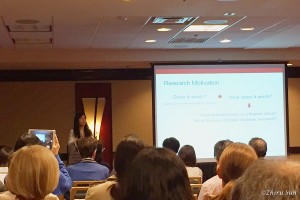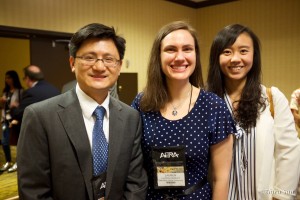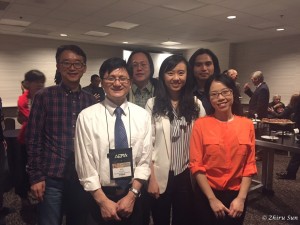Presenting the pilot study of my dissertation regarding the role of self-regulation on flipped learning
Group pic after our presentation regarding the designing for improved motivation as an outcome
(Left, Dr. Kui Xie; Middle, Dr. Lauren C. Hensley; Right, Me)
Group pic of our lab- DLRL
AERA is always a fun conference to go. So was this year’s AERA. Compared to last year, I had more diverse experience in this year’s AERA. Not only did I sit in a few interesting paper sessions, more importantly, I also presented my work in both Design and Technology SIG and Online Teaching and Learning SIG paper sessions, involved in Design and Technology SIG business meeting, and reunited with old friends and met new friends.
Both presentations went very well. My presentation regarding the role of self-regulation on flipped learning received valuable feedback and great comments, which all inspired me to continue the line of this research and investigate students’ learning patterns in flipped classes by employing the Education Data Mining (EDM) approach. Additionally, for the other presentation, I heard from Dr. Xie that some people were coming to the session just for our presentation. They were all interested in design-based research, and curious about our findings regarding the re-designed online module for a post-secondary learning strategy course. Overall, I very much enjoyed sharing our work with other interested group and were appreciated of all attention to our presentations.
Besides my own presentation, I also attended a few interesting paper sessions, and noticed that two topics are really popular in the field of education technology, which are MOOCs and game-based learning. Although MOOCs has been the buzzword since 2008, its popularity has never declined. Instead, it attracted more attention in all grade levels since then. Early work of MOOCs has been focused on investigating “who are the course takers?” This year’s presentation clearly had moved away from that topic, and emphasized on “why are they taking the course?” The presented topics include why did people enroll in MOOCs, why did teachers enroll in MOOCs professional development courses (e.g. Mitx), and how did the intention of enrolling in MOOCs impact their course performances etc. I can see the gear of MOOCs research has shifted from the new direction that examines the motivation of course takers, and attempts to use EDM to predict their performances in the course and provides adaptive feedback and support along the way.
The other trendy topic in the field of educational technology is game-based learning. Such research is mostly design-based research. Researchers themselves or researchers who collaborated with game designers developed education games in different subject areas attempting to use game elements to engage students in learning. This research is particularly prominent in STEM discipline. Two of the presentations I attended regarding this topic were supported by NSF grant, and both studies were conducted in math discipline. I am also very interested in this topic since the game-based learning environment provides a chance for learners’ immersive learning and creates opportunities for researchers to give personalized feedback on their learning based on the analysis of learners’ online learning behaviors.
Overall, this year’s AERA was a wonderful trip. One small regret for this trip was I did not have enough time to enjoy Chicago, the beautiful windy city. But at least, I went to the gift shop of the Art Institute of Chicago 🙂 Next year, 2016, will be AERA’s Centennial Year. Very looking forward to seeing everyone in D.C. next year.


